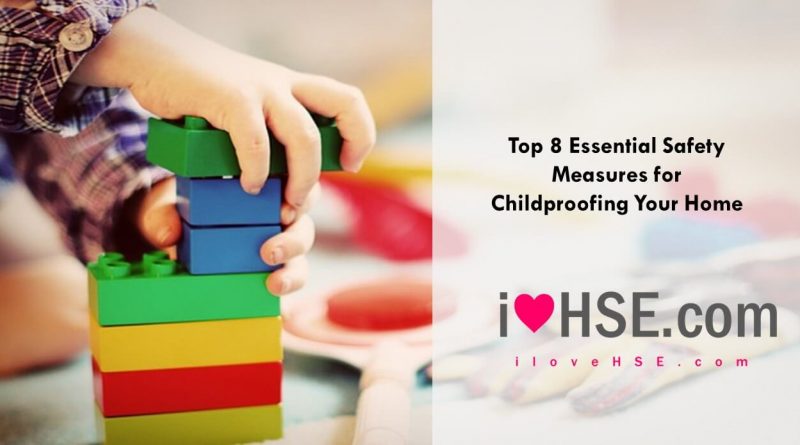Top 8 Essential Safety Measures for Childproofing Your Home
When it comes to the safety of our children, there is no compromise. Childproofing your home is essential in ensuring their well-being and minimizing potential hazards. From curious explorations to their energetic nature, children can find themselves in situations that pose risks to their health and safety. In this article, we will explore the top eight essential safety measures for childproofing your home. From securing electrical outlets to safeguarding cabinets, windows, and stoves, these measures will help you create a safe haven for your children, giving you peace of mind and allowing them to thrive in a secure environment.
List of contents
Securing Electrical Outlets
Electrical outlets are potential hazards for children, especially curious toddlers who may try to insert objects into them. To ensure their safety, invest in childproof outlet covers or outlet plates that prevent accidental contact with live electrical components. These covers are easy to install and provide a physical barrier, reducing the risk of electric shocks or burns.
Shielding Cabinets and Drawers
Cabinets and drawers can house a plethora of potential dangers, from cleaning products to sharp objects. Install childproof locks or latches on cabinets and drawers to restrict access. These locks are designed to be secure for adults but challenging for children to open. Ensure that all hazardous substances and sharp objects are stored out of reach or in locked cabinets, providing additional protection.
Securing Stoves and Ovens
The kitchen can be a hazardous area, especially regarding stoves and ovens. Use stove knob covers to prevent children from accidentally turning on burners. Install stove guards to create a physical barrier between children and hot surfaces. When cooking, turn the pot handles toward the back of the stove to avoid accidental spills or burns. Remember, constant supervision is vital in the kitchen to prevent accidents and ensure the safety of your children.
Protecting Windows and Balconies
Windows and balconies pose significant risks, especially for young children who may lean out or accidentally fall through open windows. Install window guards or stops that prevent windows from opening too wide, ensuring child safety while allowing ventilation. Consider installing window locks or latches to prevent children from opening windows without supervision. Similarly, secure balcony areas with childproof barriers to prevent falls and accidents.
Blocking Access to Hazardous Areas
Certain areas in the house may contain specific hazards that should be off-limits to children. These areas may include utility rooms, laundry rooms, or areas with heating systems. Install gates or barriers to restrict access and ensure children cannot enter these hazardous zones unsupervised. Blocking access to these areas can mitigate potential risks and maintain a safe environment for your children.
Eliminating Small Choking Hazards
Small objects pose a significant choking hazard for young children. Keep small items such as coins, buttons, or small toys out of reach. Regularly scan your home for potential choking hazards and promptly remove them from accessible areas. Be cautious with small items that could accidentally be dropped or left within reach of children, and always supervise playtime to prevent the ingestion of small objects.
Guarding Against Trips and Falls
Trips and falls are common accidents for children, especially during their early years of exploration. To minimize the risk of falls, secure area rugs with non-slip pads or remove them altogether. Install safety gates at the top and bottom of staircases to prevent falls. Keep walkways clear of clutter and ensure that furniture is anchored. You can significantly reduce the risk of falls and related injuries by eliminating trip hazards and creating a stable environment.
Managing Heat Sources
Heat sources like radiators or space heaters can pose burn risks to children. Install radiator covers to prevent accidental contact with hot surfaces. Keep portable heaters out of reach and ensure they are placed in a safe and stable position. When using stovetops or ovens, use backburners whenever possible and keep pot handles out of reach to prevent accidental spills. Teaching children about the dangers of heat sources and practicing caution in these areas is vital for their safety.
Conclusion
Childproofing your home is a vital step in ensuring the health and safety of your children. By implementing these top eight essential safety measures, including securing electrical outlets, shielding cabinets and drawers, securing stoves and ovens, protecting windows and balconies, blocking access to hazardous areas, eliminating small choking hazards, guarding against trips and falls, and managing heat sources, you can create a safe environment for your children to grow and thrive. Childproofing is an ongoing process, so regularly assess your home for potential hazards and adopt safety measures as your children increase.
Meta Description: Discover the top eight essential safety measures for childproofing your home to ensure the health and safety of your children. From securing electrical outlets to safeguarding cabinets, windows, and stoves, these measures will help create a secure environment and minimize potential hazards. Learn how to protect your little ones from accidents and complete peace of mind for you and your family.
References and Further Recomended Readings:
- Step-by-Step Guide to Childproofing Your Home – https://www.verywellfamily.com/childproofing-your-home-2634228
- A Guide To Childproofing Your Home – Cleveland Clinic – https://health.clevelandclinic.org/a-guide-to-childproofing-your-home/
- Childproofing Your Home – Several Safety Devices to Help Protect Your Children from Home Hazards | CPSC.gov – https://www.cpsc.gov/safety-education/safety-guides/kids-and-babies/Childproofing-Your-Home
- Babyproofing Your House: A Checklist for Every Room – https://www.parents.com/baby/safety/babyproofing/babyproofing-your-home-from-top-to-bottom/
- Blacknall, Sharon. The ABC’s and 123’s of Child Safety. United States, Author Solutions, Incorporated, 2012.
- Laskin, David. Parents Book of Child Safety. United States, Ballantine Books, 1991.



